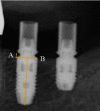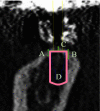Clinical Evaluation of Short (6 mm) and Longer Implants Placed Side by Side in Posterior Partially Edentulous Area: A 3-Year Observational Study
- PMID: 37456792
- PMCID: PMC10348857
- DOI: 10.1155/2023/9086628
Clinical Evaluation of Short (6 mm) and Longer Implants Placed Side by Side in Posterior Partially Edentulous Area: A 3-Year Observational Study
Abstract
Background: Short implants have been proposed as an alternative solution for the rehabilitation of atrophic posterior region.
Purpose: To compare the clinical outcomes between 6 mm short implants and conventional implants placed under similar conditions of bone quality and occlusal loading.
Materials and methods: Nine patients received atone 6 mm implant and one standard-length (8 mm length or longer) implants in a total of 10 partially edentulous areas. Implants were left submerged for 3-6 months healing period and the screw-retained splinted prostheses were delivered. When the provisional or final restoration was placed, and at each year after loading, standardized intraoral radiograph was taken for themarginal bone level (MBL) changes around the implants. Subsequently, the patients were recalled for the clinical examination evaluating the implant survival, sulcus bleeding index, suppuration, and the incidence of prosthetic complications at every 6 months after the definitive crown delivery. The observation period was continued to 3 years (mean follow-up was 3.4 ± 0.3 years) after functional loading.
Results: Nine patients (10 short implants and 10 standard length implants) were selected in this study. Cumulative survival rates of the short implants and standard-length implants were 100% in both groups, and no biological and prosthetic complication were found in 3 years observation period. Cortical bone thickness of implant insertion sites was 1.39 ± 0.45 mm at short implants and 1.38 ± 0.69 mm at standard-length implants, and trabecular bone computed tomography values of implant insertion sites was 424.1 ± 290.1 at short implants and 410.9 ± 267.9 at standard-length implants. The MBL changes were -0.30 ± 0.71 mm at short implants and -0.19 ± 0.78 mm at standard-length implants at 3 years follow-up visit. No significant difference was found in the average of MBL changes between implant length.
Conclusions: Within the limits of this study, it can be concluded that 6 mm short implants in a posterior edentulous region showed excellent results compared with conventional implants.
Copyright © 2023 Masahiro Shimogishi et al.
Conflict of interest statement
The authors declare that they have no conflicts of interest.
Figures



References
-
- Wittneben J.-G., Wismeijer D., Brägger U., Joda T., Abou-Ayash S. Patient-reported outcome measures focusing on aesthetics of implant- and tooth-supported fixed dental prostheses: a systematic review and meta-analysis. Clinical Oral Implants Research . 2018;29(S16):224–240. doi: 10.1111/clr.13295. - DOI - PubMed
-
- Moraschini V., da C. Poubel L. A., Ferreira V. F., dos S. P. Barboza E. Evaluation of survival and success rates of dental implants reported in longitudinal studies with a follow-up period of at least 10 years: a systematic review. International Journal of Oral & Maxillofacial Surgery . 2015;44(3):377–388. doi: 10.1016/j.ijom.2014.10.023. - DOI - PubMed
-
- Bechara S., Nimcenko T., Kubilius R. The efficacy of short (6 mm) dental implants with a novel thread design. Stomatologija . 2017;19(2):55–63. - PubMed
LinkOut - more resources
Full Text Sources
Miscellaneous

